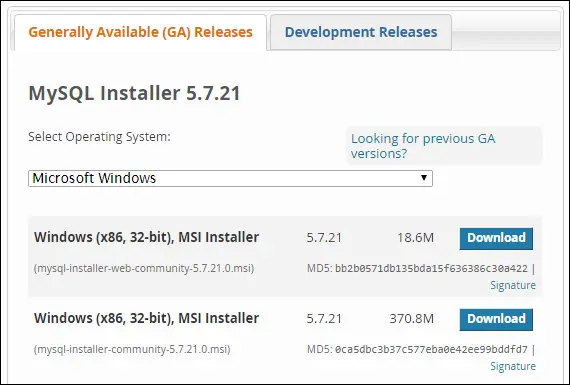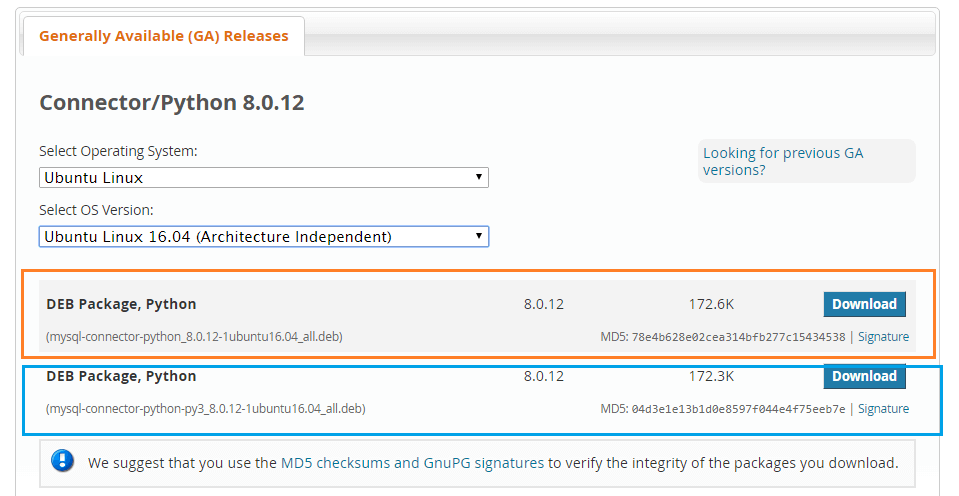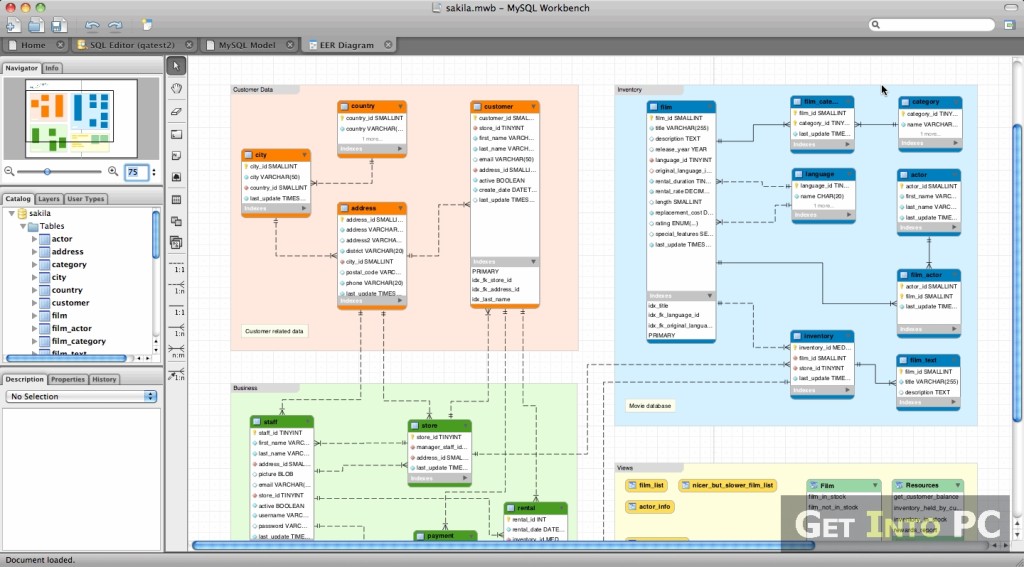Run the MySQL installer. Complete additional MySQL configuration. Configure MySQL with a root password. Reboot your computer to restart MySQL. Download the Specify installer package for Mac OS from the Specify Software. Choosing the right file: If you have an online connection while running the MySQL Installer, choose the mysql-installer-web-community file.; If you do NOT have an online connection while running the MySQL Installer, choose the mysql-installer-community file.; Note: MySQL Installer is 32 bit, but will install both 32 bit and 64 bit binaries.
MySQL Workbench provides DBAs and developers an integrated tools environment for:
- Database Design & Modeling
- SQL Development
- Database Administration
- Database Migration
The Community (OSS) Edition is available from this page under the GPL.
Download source packages of LGPL libraries: [+]
The following LGPL libraries are used by MySQL Workbench and their sources are provided for download in compliance with the LGPL. You do not need to download them if you use MySQL Workbench binaries provided by us or compile MySQL Workbench using pre-compiled libraries obtained from elsewhere.
for OS X:
for Windows:
MySQL Workbench Windows Prerequisites:
To be able to install and run MySQL Workbench on Windows your system needs to have libraries listed below installed. The listed items are provided as links to the corresponding download pages where you can fetch the necessary files.
To learn more about MySQL Workbench:
- MySQL Workbench Installation Instructions, Documentation and Change History
- Forums and Blogs
Looking for the legacy MySQL GUI Tools Bundle (Administrator, Query Browser, Migration Toolkit)?
- Read the EOL Announcement for the MySQL GUI Tools Bundle
Please report any bugs or inconsistencies you observe to our Bugs Database.
Thank you for your support!
Install Mysql For Mac
Chapter 3. Installing and Launching MySQL Workbench
Table of Contents
- 3.1. Hardware Requirements
- 3.2. Software Requirements
- 3.3. Starting MySQL Workbench
- 3.3.1. Installing MySQL Workbench on Windows
- 3.3.2. Launching MySQL Workbench on Windows
- 3.3.3. Uninstalling MySQL Workbench on Windows
- 3.3.4. Installing MySQL Workbench on Linux
- 3.3.5. Launching MySQL Workbench on Linux
- 3.3.6. Uninstalling MySQL Workbench on Linux
- 3.3.7. Installing MySQL Workbench on Mac OS X
- 3.3.8. Launching MySQL Workbench on Mac OS X
- 3.3.9. Uninstalling MySQL Workbench on Mac OS X
- 3.4. Activation Procedure (Commercial Version)

MySQL Workbench is available for the following platforms:
Binary distributions of MySQL Workbench are avaliable for the above platforms. Source code distributions are also available as a tar.gz package, or an RPM package.
The following sections explain the installation process for each of these platforms.
MySQL Workbench requires a current system to run smoothly. The minimum hardware requirements are:
CPU: Intel Core or Xeon 3GHz (or Dual Core 2GHz) or equal AMD CPU
Cores: Single (Dual/Quad Core is recommended)
RAM: 4 GB (6 GB recommended)
Graphic Accelerators: nVidia or ATI with support of OpenGL 1.5 or higher
Display Resolution: 1280×1024 is recommended, 1024×768 is minimum.
The following operating systems are officially supported:
Windows 7 (64-bit, Professional level or higher)
Mac OS X 10.6.1+
Ubuntu 9.10 (64bit)
Ubuntu 8.04 (32bit/64bit)
For convenience the following builds are also available:
Windows XP SP3, Vista
Mac OSX (10.5 and 10.6) Intel
Ubuntu 8.04 (i386/x64)
Ubuntu 9.04 (i386/x64)
Fedora 11 (i386/x64)
MySQL Workbench also has the following general requirements:
The Microsoft .NET 3.5 Framework.
Cairo 1.6.0 or later
glib-2.10
libxml-2.6
libsigc++ 2.0
pcre
libzip
For convenience the Windows libraries are available as the download “Dependencies for Compiling in Windows”.
On start up, the application checks the OpenGL version and selects between software and hardware rendering. To determine the rendering method that is being used, open the Help menu and choose the System Info submenu.
- 3.3.1. Installing MySQL Workbench on Windows
- 3.3.2. Launching MySQL Workbench on Windows
- 3.3.3. Uninstalling MySQL Workbench on Windows
- 3.3.4. Installing MySQL Workbench on Linux
- 3.3.5. Launching MySQL Workbench on Linux
- 3.3.6. Uninstalling MySQL Workbench on Linux
- 3.3.7. Installing MySQL Workbench on Mac OS X
- 3.3.8. Launching MySQL Workbench on Mac OS X
- 3.3.9. Uninstalling MySQL Workbench on Mac OS X
The procedure for launching MySQL Workbench depends on the platform. Generally, there are two ways to launch MySQL Workbench from the command line and from the graphical user interface of the host operating system. Using the command-line launching facility is useful when you want to customize some aspects of the way MySQL Workbench operates. Launching MySQL Workbench for each of the supported platforms is described in the following sections.
In addition to platform-specific command line options, MySQL Workbench has the following command line options:
--admin- Launch MySQL Workbench and load the server instance specified.instance--query- Launch MySQL Workbench and load the connection specified.connection--model- Launch MySQL Workbench and load the model specified.modelfile--script- Launch MySQL Workbench and run the script specified.script--run- Launch MySQL Workbench and run the code snippet specified.code--quit-when-done- quits MySQL Workbench after --script or --run finishes.
MySQL Workbench may be installed using the Windows installer file or it may be installed manually from a ZIP file.
Installing MySQL Workbench Using the Installer
MySQL Workbench can be installed using the Windows Installer (.msi) installation package. The MSI package bears the name mysql-workbench-, where version-win32.msiversion indicates the MySQL Workbench version number.
Installing MySQL Workbench using the installer requires either Administrator or Power User privileges. If you are using the ZIP file without an installer, you do not need Administrator or Power User privileges.
Improving the MySQL Installation Wizard depends on the support and feedback of users. If you find that the MySQL Installation Wizard is lacking some feature important to you, or if you discover a bug, please report it in our bugs database. To do this use the Report a Bug option under the Help menu.
To install MySQL Workbench, right-click the MSI file and select the Install option from the pop-up menu, or simply double-click the file.
In the Setup Type window you may choose a
CompleteorCustominstallation. To use all features of MySQL Workbench choose theCompleteoption.Unless you choose otherwise, MySQL Workbench is installed in
C:, where%PROGRAMFILES%MySQLMySQL Workbench 5.1edition_type%PROGRAMFILES%is the default directory for programs for your locale. The%PROGRAMFILES%directory may beC:Program FilesorC:programme.
Installing from the ZIP File
If you are having problems running the installer, as an alternative, you can download a ZIP file without an installer. That file is called mysql-workbench-. Using a ZIP utility, unpack it to the directory of your choice. You may also want to create a shortcut on your desktop or the quick launch bar. version-win32.zip
To install using the ZIP file, download the ZIP file to a convenient location and decompress the file. You can place the resulting directory anywhere on you system. You do not need to install or configure the application before using it.
To start MySQL Workbench on Windows select Start, Programs, MySQL and then select MySQL Workbench.
You may also start MySQL Workbench from the command line. To view the available command-line options, issue the command MySQLWorkbench -help | more from the MySQL Workbench installation directory. You will see the following output:
The MySQL Workbench version number is displayed followed by a usage message and then the options. Use the -swrendering option if your video card does not support OpenGL 1.5. The -version option can be used to display the MySQL Workbench version number. The -grtversion can be used to display the GRT shell version number. The other options are self-explanatory.
When using command-line options that display output to a console window, namely -help and -version, be sure that you pipe the output through the more command otherwise nothing will be displayed.
The method for uninstalling MySQL Workbench will depend on how you install MySQL Workbench in the first place.
Rmoving MySQL Workbench when installed Using the Installer
To uninstall MySQL Workbench, open the Control Panel and Choose Add or Remove Programs. Find the MySQL Workbench entry and choose the button. Doing this will remove MySQL Workbench.
Any modules added to the
C:Program FilesMySQLMySQL Workbenchdirectory will not be deleted.versionmodules
It is not possible to remove MySQL Workbench from the command line if you have installed MySQL Workbench using the installer. Although you can manually remove some of the compoentns There is no command-line option for removing MySQL Workbench.
Removing the MySQL Workbench directory manually will not remove all the files belonging to MySQL Workbench.
When installed from a ZIP file
If you installed MySQL Workbench using a ZIP file, to remove MySQL Workbench you can just delete the MySQL Workbench directory.
If you installed any additional modules within the modules directory and you want to keep them, make sure you copy those modules to a different directory before deleting the MySQL Workbench directory.
There are several binary distributions of MySQL Workbench available for Linux. These include:
Fedora 10 amd64 (RPM)
Ubuntu 8.04 i386 (DEB)
Ubuntu 8.10 amd64 (DEB)
In addition to the binary distributions, it is also possible to download the MySQL Workbench source code as a tar.gz or RPM package.
Check the MySQL Workbench download page for the latest packages.
The procedure for installing on Linux depends on which Linux distribution you are using.
Installing DEB packages
On Ubuntu, and other systems that use the Debian package scheme, you can install MySQL Workbench using a command such as:
Note that package.debmysql-workbench-oss-, where version_i386.debversion is the MySQL Workbench version number.
You may be warned that certain libraries are not available, depending on what you already have installed. Install the required libraries and then install the MySQL Workbench package again.
Installing RPM packages

On RedHat-based systems, and other systems using the RPM package format, MySQL Workbench can be installed by a command such as:
Again, note that package.rpmmysql-workbench-oss-, and version-1fc10.x86_64.rpmversion is the MySQL Workbench version number.
Once MySQL Workbench has been installed it can be launched by selecting Applications, Programming, MySQL Workbench from the main menu.
MySQL Workbench can also be launched from the command line on Linux. Type the command:
This will display the available command-line options:
The procedure for uninstalling MySQL Workbench on Linux depends on the packe you are using.
Uninstalling DEB packages
For Debian packages the command is:
This does not remove the configuration files. If you wish to also remove the configuration files use:

Uninstalling RPM packages
To uninstall RPM packages use:
This does not remove the configuration files.
MySQL Workbench is available for Mac OS X and is distributed as a DMG file. The file is named mysql-workbench-oss-, where version-osx10.5-i686.dmgversion is the MySQL Workbench version.
Mysql Installer For Mac Download Windows 10
To install MySQL Workbench on Mac OS X, simply download the file. Double-click the downloaded file. You will be presented with the installation screen:
Mysql Installer For Mac Download Software
Figure 3.1. MySQL Workbench Mac OS X Installation Screen
Drag the MySQL Workbench icon onto the Application icon as instructed. MySQL Workbench is now installed.
You can now launch MySQL Workbench from the Applications folder.
To launch MySQL Workbench on Mac OS X, simply open the Applications folder in the Finder, then double-click MySQL Workbench.
It is also possible to start MySQL Workbench from the command line:
Install Mysql Server Mac
A model file must be specified.
Mysql For Mac
To uninstall MySQL Workbench for Mac OS X, simply locate MySQL Workbench in the Applications folder, right-click, and select Move to Trash. The application is uninstalled.